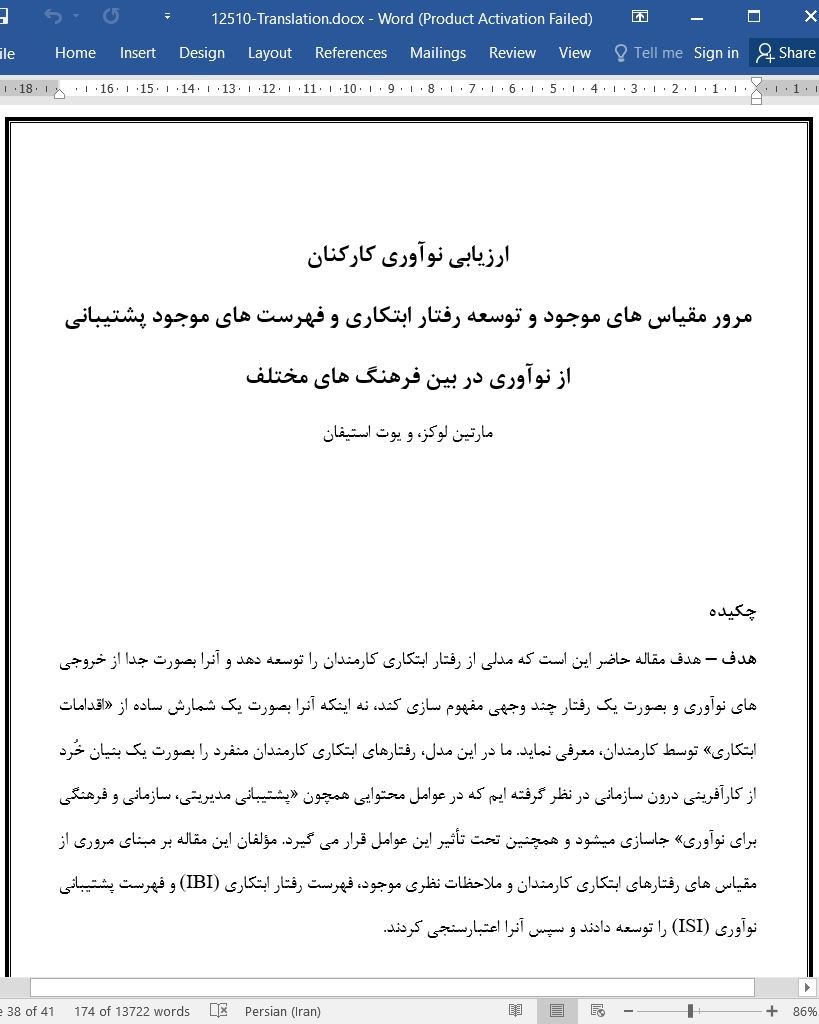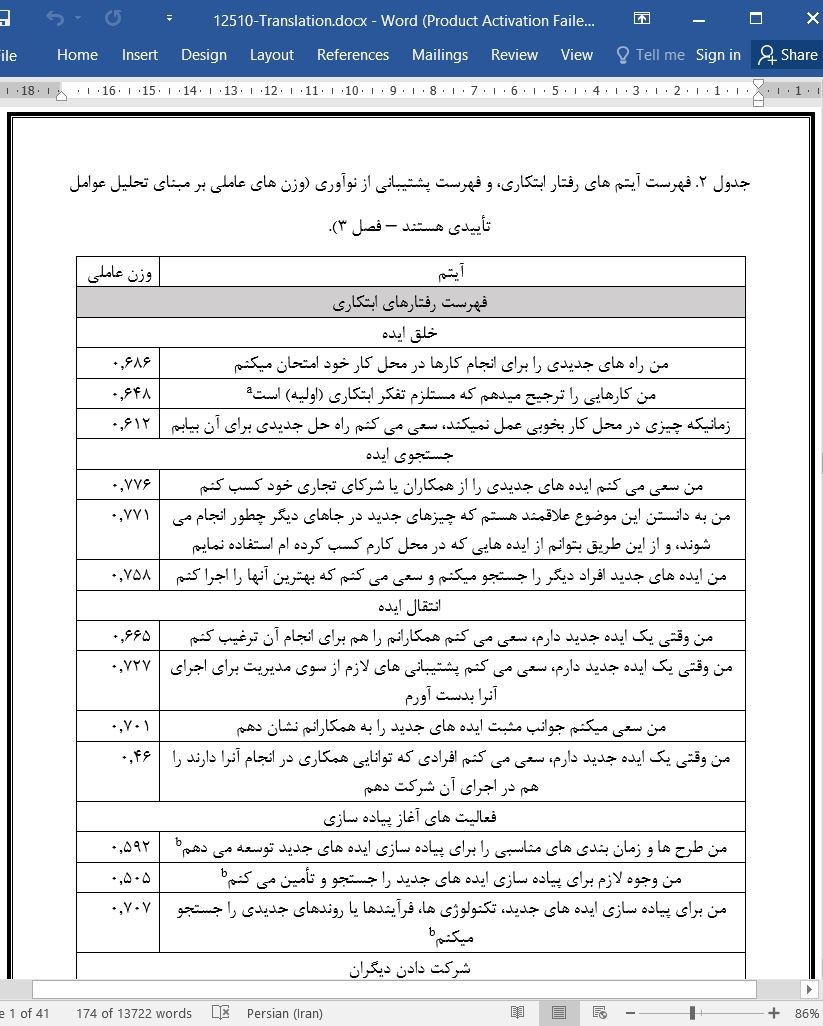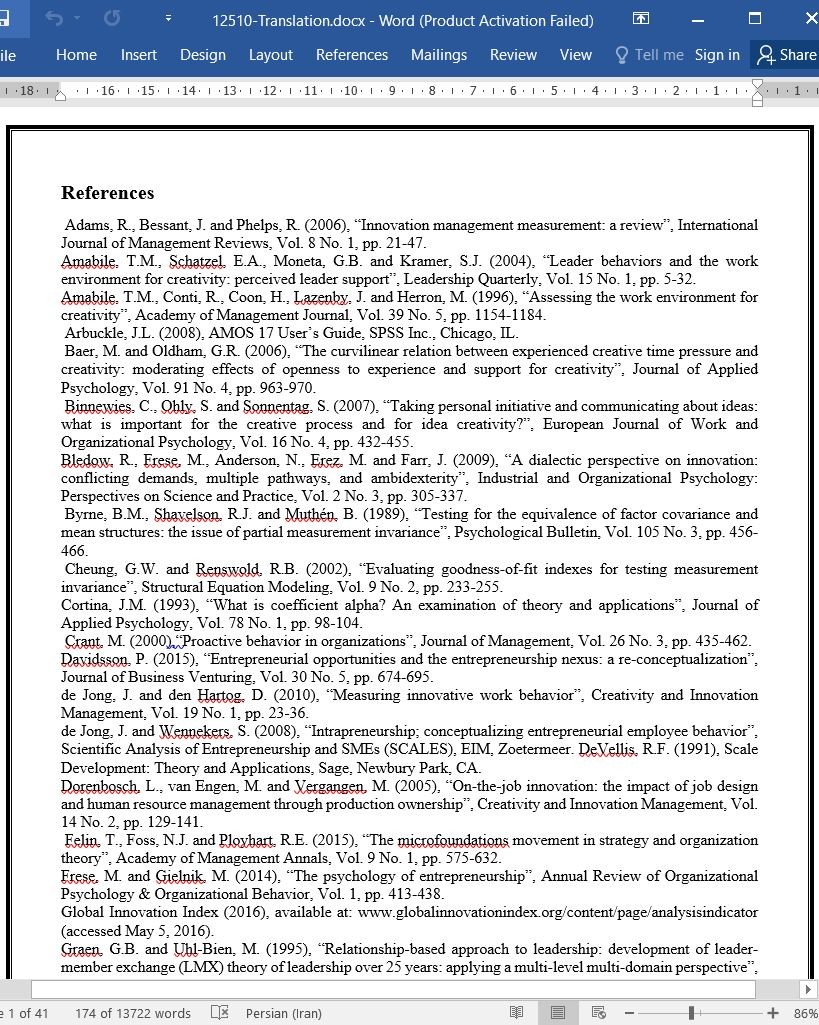
دانلود مقاله ارزیابی نوآوری کارکنان
چکیده
هدف – هدف مقاله حاضر این است که مدلی از رفتار ابتکاری کارمندان را توسعه دهد و آنرا بصورت جدا از خروجی های نوآوری و بصورت یک رفتار چند وجهی مفهوم سازی کند، نه اینکه آنرا بصورت یک شمارش ساده از «اقدامات ابتکاری» توسط کارمندان، معرفی نماید. ما در این مدل، رفتارهای ابتکاری کارمندان منفرد را بصورت یک بنیان خُرد از کارآفرینی درون سازمانی در نظر گرفته ایم که در عوامل محتوایی همچون «پشتیبانی مدیریتی، سازمانی و فرهنگی برای نوآوری» جاسازی میشود و همچنین تحت تأثیر این عوامل قرار می گیرد. مؤلفان این مقاله بر مبنای مروری از مقیاس های رفتارهای ابتکاری کارمندان و ملاحظات نظری موجود، فهرست رفتار ابتکاری (IBI) و فهرست پشتیبانی نوآوری (ISI) را توسعه دادند و سپس آنرا اعتبارسنجی کردند.
طراحی/روش/رویکرد – دو مطالعه مقدماتی، یک مطالعه اعتبارسنجی سوم در جمهوری چک، و یک مطالعه اعتبارسنجی میان فرهنگی چهارم با استفاده از نمونه های معرف جمعیت از سوئیس، آلمان، ایتالیا و جمهوری چک (n = 2,812 کارمند و 450 کارآفرین ) انجام شد.
یافته ها – هر دو فهرست قابل اطمینان بودند و اعتبارهای عاملی، ملاک، همگرا و افتراقی، و همچنین برابری میان فرهنگی را نشان دادند. رفتار ابتکاری کارمندان حمایت شد؛ این رفتار متشکل از ایده زایی، جستجوی ایده، ابلاغ ایده، فعالیت های اجرایی آغازین، شرکت دادن دیگران، و غلبه بر موانع بود. پشتیبانی مدیریتی، مهمترین تأثیر محتوایی را بر روی رفتار ابتکاری داشت و واسطه ای برای تأثیر «پشتیبانی سازمانی و فرهنگ ملی» بود.
ابتکار/ارزش – این مقاله درک خواننده از رفتار ابتکاری کارمندان – بعنوان یک پدیده چند وجهی – و عوامل محتوایی تأثیرگذار بر آنرا افزایش میدهد. با اینکه تحقیقات قبلی معمولاً بر نمونه های ساده در یک کشور خاص تمرکز کرده اند، اما مؤلفان مقاله حاضر اولین شواهد قوی را ارائه میدهند که مدل رفتار ابتکاری کارمندان را در بین فرهنگ ها و انواع مختلفی از نمونه ها تعمیم میدهد. این مدل و فهرست های IBI و ISI محققان را قادر می سازند که به درک عمیق تری از بنیان خرد مهم رفتار کارآفرینی مبنا در سازمان ها برسند؛ متخصصین نیز می توانند از این طریق نقاط قوت و نقاط ضعیف سازمان های خود در رابطه با کارآفرینی را شناسایی کنند.
1. مقدمه
نوآوری و کارآفرینی، محرک های کلیدی هستند که مبنای مزیت رقابتی سازمان ها را تشکیل میدهند. مقالات رو به رشد در مورد کارآفرینی تلاش می کنند تا روحیه کارآفرینی و ابتکاری را در سازمان های بزرگ ترویج کنند (هورنزبای و همکارانش 1999؛ پارکر 2011؛ پارک و همکارانش 2014). رفتار ابتکاری فردی کارمندان یک بنیان خرد (فلین و همکارانش 2015) را برای نوآوری و کارآفرینی سازمانی تشکیل میدهند. با اینحال این مسئله بخوبی مشخص نشده است که این رفتار کارآفرینی و ابتکاری کارمندان منفرد را چطور باید ارزیابی کنیم (آدامز و همکارانش 2006). مطالعات موجود معمولاً ابزارهای سنجش کلی ساده را بررسی کرده اند یا جنبه های خاصی از رفتار ابتکاری کارمندان را برای بررسی کردن انتخاب کرده اند. مطالعات موجود معمولاً فقط در یک کشور، و غالباً هم فقط در یک سازمان خاص انجام شده اند و نمونه ساده ای از یک نوع خاص از کارمندان – همچون متخصصان تحقیق و توسعه – را در نظر گرفته اند (برای مشاهده یک مورد استثنا نگاه کنید به پاترسون و همکارانش 2005).
6. نتیجه گیری ها
بطور کلی مقاله حاضر به درک ما از ماهیت چند وجهی رفتار ابتکاری کارکنان و عوامل زمینه ای – که از نوآوری پشتیبانی می کنند – می افزاید. این مقاله با استفاده از یک رویکرد ساخت مقیاس یکپارچه، ابزارهای سنجش قابل اطمینانی (یعنی IBI و ISI) را فراهم می سازد که دارای اعتبارهای عاملی، ملاک، همگرا و افتراقی خوبی هستند. IBI و ISI درک مختصر و تازه ای را در مورد جنبه های مختلف رفتار ابتکاری کارکنان فراهم می سازند. برای محققان، مدل نظری پیشنهاد شده سبب درک رفتار ابتکاری کارکنان می گردد؛ این رفتار ابتکاری کارکنان قابل سنجش است و برای انواع مختلف نوآوری و گروه های کارکنان، کاربردپذیر است. تا جاییکه ما می دانیم، این اولین مقیاس رفتار ابتکاری ارائه شده است که برای انواع مختلفی از حرفه ها آزمایش شده است و برای فرهنگ های مختلف قابل اعمال است. این مقیاس می تواند برای تحقیقاتی سودمند باشد که بر رفتار فردی – بعنوان یک بنیان خرد برای کارآفرینی درون سازمانی – تمرکز کرده اند. برای مدیران و متخصصانی که با موضوع نوآوری سر و کار دارند، یک درک آگاهانه از رفتارهای ابتکاری و عوامل حامی نوآوری، می تواند به آنها کمک کند تا تلاش های خود را بر مبنای نقاط قوت نوآوری پایه ریزی کنند، نقاط ضعف را کاهش دهند، و [تلاشهای] نوآوری خود را به شیوه مؤثرترین مدیریت کنند.
Abstract
Purpose – The purpose of this paper is to develop a model of employee innovative behavior conceptualizing it as distinct from innovation outputs and as a multi-faceted behavior rather than a simple count of “innovative acts” by employees. It understands individual employee innovative behaviors as a microfoundation of firm intrapreneurship that is embedded in and influenced by contextual factors such as managerial, organizational and cultural support for innovation. Building from a review of existing employee innovative behavior scales and theoretical considerations the authors develop and validate the Innovative Behavior Inventory (IBI) and the Innovation Support Inventory (ISI).
Design/methodology/approach – Two pilot studies, a third validation study in the Czech Republic and a fourth cross-cultural validation study using population representative samples from Switzerland, Germany, Italy and the Czech Republic (n ¼ 2,812 employees and 450 entrepreneurs) were conducted.
Findings – Both inventories were reliable and showed factorial, criterion, convergent and discriminant validity as well as cross-cultural equivalence. Employee innovative behavior was supported as comprising of idea generation, idea search, idea communication, implementation starting activities, involving others and overcoming obstacles. Managerial support was the most proximal contextual influence on innovative behavior and mediated the effect of organizational support and national culture.
Originality/value – The paper advances the understanding of employee innovative behavior as a multifaceted phenomenon and the contextual factors influencing it. Where past research typically focuses on convenience samples within a particular country, the authors offer first robust evidence that the model of employee innovative behavior generalizes across cultures and types of samples. The model and the IBI and ISI inventories enable researchers to build a deeper understanding of the important micro-foundation underpinning intrapreneurial behavior in organizations and allow practitioners to identify their organizations’ strengths and weaknesses related to intrapreneurship.
1. Introduction
Innovation and intrapreneurship are key drivers underlying the competitive advantage of organizations. The flourishing literature on intrapreneurship seeks to leverage entrepreneurial and innovative spirit for larger organizations (Hornsby et al., 1999; Parker, 2011; Park et al., 2014). Employee individual innovative behavior constitutes a micro-foundation (Felin et al., 2015) of organizational innovation and intrapreneurship. Yet, it is less well established how such individual employee intrapreneurial, innovative behavior should be measured (Adams et al., 2006). Studies typically consider either simplistic overall measures, or single out particular aspects of employee innovative behavior. They are typically conducted in one country, often in one particular organization, considering a convenience sample of a particular type of employees such as R&D professionals (for an exception Patterson et al., 2005).
6. Conclusion
Overall, this paper adds to our understanding of the multi-faceted nature of employee innovative behavior and contextual factors supporting innovation. Using an integrative scale building approach, it offers reliable measures – IBI and ISI – with good factorial, criterion, convergent and discriminant validity. IBI and ISI offer a concise yet nuanced understanding of the multiple facets of employee innovative behavior. For researchers, the suggested theoretical model provides an understanding of employee innovative behavior that is measurable and widely applicable for different innovation types and employee groups. It offers, to our knowledge, the first innovative behavior scale that is tested for broad variety of occupations and is cross-culturally applicable. It may be useful for research that focuses on individual behavior as a micro-foundation of intrapreneurship. For managers and practitioners dealing with the topic of innovation, an informed understanding of innovative behaviors and innovation supporting factors may help them to build on innovation strengths, reduce weaknesses and manage their innovation more efficiently.
چکیده
1. مقدمه
2. یک مدل یکپارچه از رفتار ابتکاری کارمندان، و پشتیبانی از آن
2.1 رفتار ابتکاری کارکنان
2.2 پشتیبانی از نوآوری
3. مرور ابزارهای سنجش موجود برای خلاقیت، رفتار ابتکاری کارکنان، و پشتیبانی از نوآوری
4. توسعه مقیاس
4.1 مطالعه 1: ساخت استخر آیتم
4.2 مطالعه 2: مطالعه مقدماتی در مورد اعتبار ملاک
4.3 مطالعه 3: اعتبارهای عاملی، همگرا و افتراقی
4.4 مطالعه 4: اعتبارسنجی میان فرهنگی روی نمونه های معرف جمعیت بزرگسالان در چهار فرهنگ اروپایی
5. بحث
6. نتیجه گیری ها
منابع
Abstract
1. Introduction
2. An integrative model of employee innovative behavior and its support
2.1 Employee innovative behavior
2.2 Innovation support
3. A review of existing measures of creativity, employee innovative behavior and innovation support
4. Scale development
4.1 Study 1: construction of item pool
4.2 Study 2: pilot study on criterion validity
4.3 Study 3: factorial, convergent and discriminant validity
4.4 Study 4: cross-cultural validation on representative samples of adult population in four European cultures
5. Discussion
6. Conclusion
References
- اصل مقاله انگلیسی با فرمت ورد (word) با قابلیت ویرایش
- ترجمه فارسی مقاله با فرمت ورد (word) با قابلیت ویرایش، بدون آرم سایت ای ترجمه
- ترجمه فارسی مقاله با فرمت pdf، بدون آرم سایت ای ترجمه



